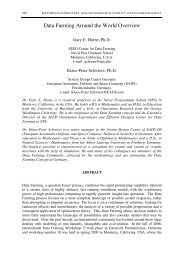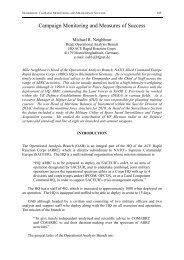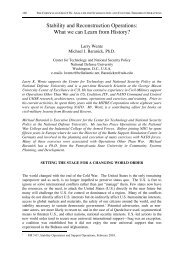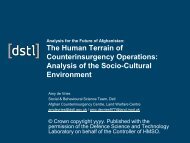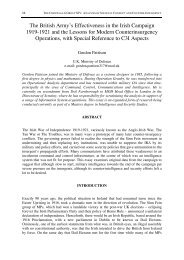Modeling Stability and Reconstruction Operation ... - Cornwallis Group
Modeling Stability and Reconstruction Operation ... - Cornwallis Group
Modeling Stability and Reconstruction Operation ... - Cornwallis Group
You also want an ePaper? Increase the reach of your titles
YUMPU automatically turns print PDFs into web optimized ePapers that Google loves.
230 THE CORNWALLIS GROUP XI: ANALYSIS FOR CIVIL-MILITARY TRANSITIONS<strong>and</strong> growth of the organizational membership by providing tangible <strong>and</strong> intangible benefits,<strong>and</strong> citizens subscribe based on a perceived level of benefit that is received from theorganization. Additionally, through inter-organization networks, attitudes <strong>and</strong> resources maybe shared among organizations. Through these internal <strong>and</strong> external interactions,organizations cause significant changes in perception <strong>and</strong> attitude change <strong>and</strong> become coreprotagonists of activism in the model. In turn, an organization exercises its power throughthe control over its resources <strong>and</strong> its ability to procure <strong>and</strong> maintain its resource base.Institution agents are represented as ‘governmental entities’ such as the army, police,legislature, courts, executive, bureaucracy, <strong>and</strong> political parties—entities that are able toformulate policies that have legal binding, <strong>and</strong> have more discretionary resources. SEASmodels institutions as structures that are products of individual choices or preferences, beingconstrained by the institutional structures (i.e. an interactive process). Institutions are likeformal organizations with an additional power to influence the behaviors of members <strong>and</strong>non-members.Media agents also play a significant role in providing information to other agents in theform of reports on well-being <strong>and</strong> attitudes. Media organizations consist of television, radio,newspapers, <strong>and</strong> magazines. The media make choices of what information to cover, who tocover, what statements to report, what story elements to emphasize <strong>and</strong> how to report them.Incidents are framed on well-being components, <strong>and</strong> formalized in a media report. Media isable to set the agenda for domestic policies as well as foreign policy issues. Citizenssubscribe to media organizations based on their ideological bend. Media organizations actprimarily to frame the issues for their audiences in such a way that they increase their viewershipas well as their influence.Agents emulate the behavior of the entity it represents via the possible engagementoptions available to that agent <strong>and</strong> the environment that it is operating within. In essence, theagent intelligence represents the possible exchanges between the agent’s attributes <strong>and</strong> traits,on the one h<strong>and</strong>, <strong>and</strong> the agent’s environment comprised of a host of other dissimilar agents,on the other h<strong>and</strong>. The rules of engagement are known for any class of agents <strong>and</strong> areconfigured for a particular experiment. This intelligence consists of seven “behaviorprimitives” that describe the range of possible actions: initiate, search, decide, execute,update, communicate <strong>and</strong> terminate. Specific algorithms are used to describe the intensity ofparticular classes of agent intelligence <strong>and</strong> to affect the agent behavior with respect toexternal stimuli.Agents interact with the environment <strong>and</strong> respond, that is take actions, to exogenousvariables that may be specified by human agents or players in the environment as well asinputs from other agents. This is implemented with the introduction of inputs <strong>and</strong> outputs thateach agent possesses. Inputs consist of general “environmental sensors” as well as particular“incoming message sensors.” The incoming message sensors are singled out by each agent asagents have the ability to query messages from the environment discriminately. The agentalso possesses ports characterized collectively as “external actions” that allow the agent tosubmit its actions or messages to the environment. Finally, the agent possesses an internal setof rules classified as “internal actions” that result in the agents “external actions” on the basisof the sensor inputs as well as the traits/attributes <strong>and</strong> intelligence structure of each agent.Algorithms, which are differentiated for a specific type of agent, are embedded into eachagent to create a decision-making ability. These algorithms enable up to five decision-



